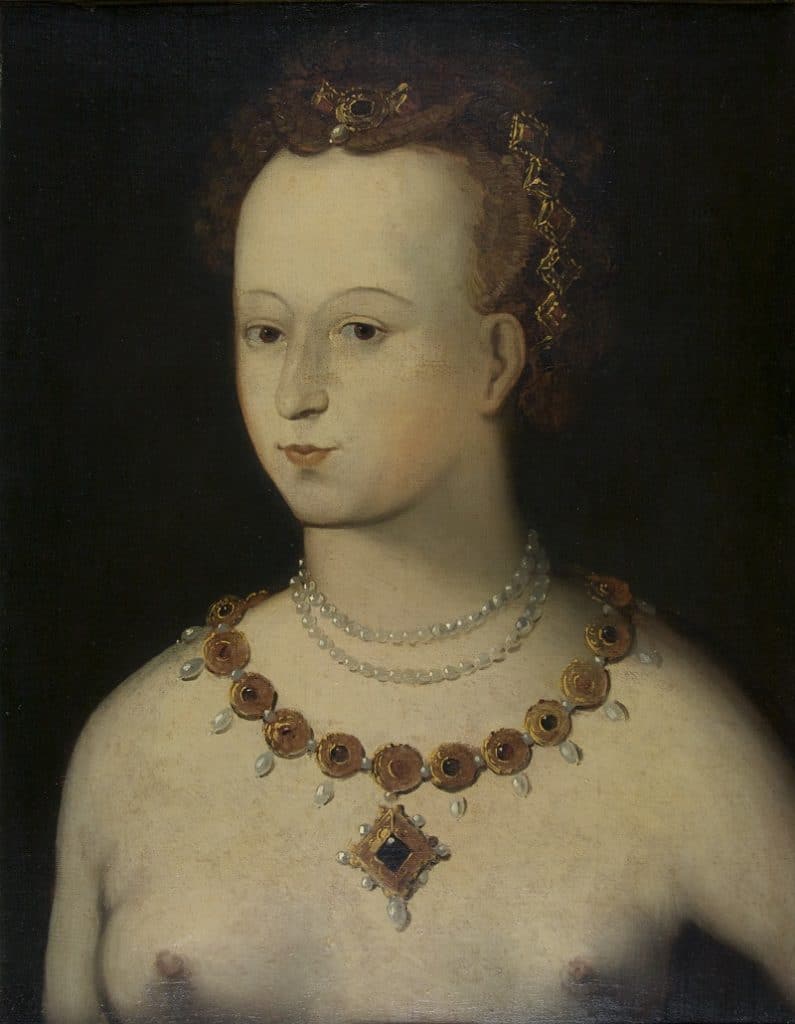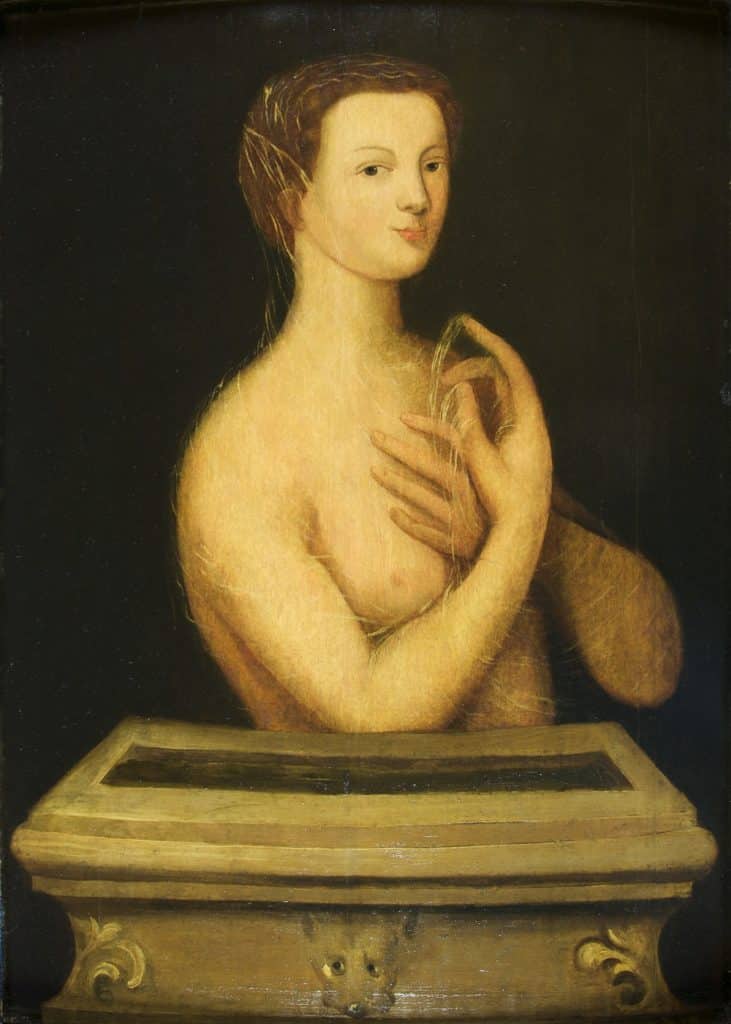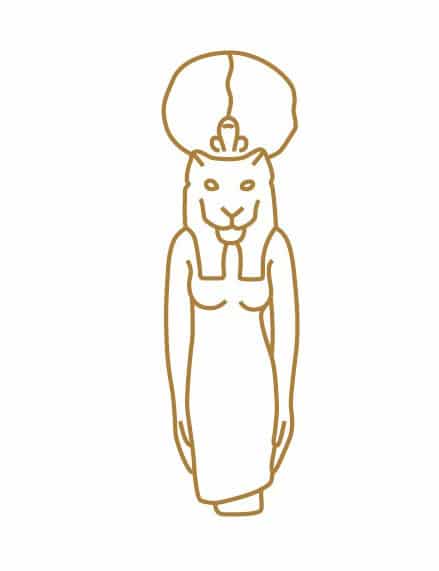
Fig. 1, Jane Shore, artist unknown, oil on canvas, 470 x 350mm. [FDA-P.38-2010]

Fig. 2, Jane Shore with Stone Basin, artist unknown, oil on panel, 890 x 650mm, British School 18th century c. 1704-30. [FDA-P.114-2010]
With Eton College in lockdown, its ghosts are free to roam the corridors. Amongst Eton’s most famous supernatural residents is Jane Shore – mistress to Edward IV (1442 – 1483) – who has long been credited with saving the College from closure by the new Yorkist king. In the Eton College Collections are two paintings, both artists unknown, believed to portray her. The first, ‘Jane Shore’ (FDA-P.38-2010) (Fig. 1), is a half-length nude portrait depicting its subject wearing an elaborate necklace and adorned with jewels in her hair. Oil on canvas and probably painted in the seventeenth century, it is a copy of an almost identical panel painting belonging to King’s College Cambridge, which has been dendrochronologically dated to 1550-60. The second portrait, ‘Jane Shore with stone basin’ (FDA-P.114-2010) (Fig. 2), has been dated to the early eighteenth century, around 1704-30, and portrays a woman wearing diaphanous muslin, standing by a stone basin carved in the classical style.[1]
The provenance of both paintings has long been the subject of debate. The first portrait (Fig. 1) is the better-documented of the two. Sir Robert Birley (Head Master of Eton 1949 – 1964) traced Eton’s possession of it to the first half of the seventeenth century and came to the conclusion that the portraits could only be here because someone thought it “appropriate”; “this could only be because [Jane] had helped [Eton]”.[2] Similarly, Henrietta Ryan (Keeper of Paintings, Prints and Drawings 2004 – 2013), notes the significance of “the presence of these paintings among the historical portraits of monarchs and other celebrated figures connected with the [College’s history]”.[3]
Eton College was founded by the Lancastrian King Henry VI in 1440. At Parliament in November 1461, having overthrown Henry at the Battle of Towton, Edward IV pronounced all grants made by the Lancastrian kings void. By November 1463, Edward had decided to annexe much of Eton’s land and treasures to St George’s, Windsor. This redistribution of Eton’s wealth had a hugely detrimental effect. Although it is not believed that the school closed entirely, Maxwell-Lyte notes that “the College revenues, which had once amounted to some 1,500l. a year, had, by 1468, sunk to 370l.”[4] By 1469, Eton’s state of affairs had improved, although it is not documented how exactly the school recovered the King’s favour. Neither is there any contemporary evidence that details quite how Jane Shore fits into Eton’s rise to stability. Some scholars point to the newly elected Provost of Eton in 1477, Henry Bost, who is believed to have been Jane Shore’s confessor. Others direct us to Sir Thomas More’s History of King Richard III, which was published posthumously in 1557. More is reputed to have met Jane Shore in her later years, and wrote the following of her influence over Edward IV:
“…where the King took displeasure, she would mitigate and appease his mind; where men were out of favour, she would bring them in his grace; for many who had highly offended, she obtained pardon; of great forfeitures she got men remission…”[5]
It is possible that More’s statement on Jane’s character provided the circumstantial scope for successive scholars to fill in the gaps with conjecture; the earliest known example comes from Memoirs of the Lives of King Edward IV and Jane Shore, written by an anonymous author in 1714:
“I remember to have seen another [painting of Jane Shore], many years ago, in the Library at Eton, but cannot recollect in what dress or posture she is there drawn. They have good Reason to preserve this Piece…for that College being founded by King Henry VI Edward, who deposed him, had a design of Alienating the Revenues to another, and had done so, if Jane Shore had not interpos’d…”[6]
Certainly Jane Shore has become, over the centuries, a popular figure in Eton’s mythohistory. When living in the Cloisters in 1956, Fiona Marsland was often “conscious of a dark figure, coming slowly up the stairs.” A letter written by her husband Geoffrey and held in the Eton College Archives (COLL_P_21_07) continues the story:
“At first she thought it was a boy in school dress, but soon changed that view when the figure disappeared as she turned round to look at it. Gradually however, as Fiona grew more confident – for she had a really good feeling about whatever it was – the figure came further and further up the stairs, onto the landing and stood at the door of the kitchen watching [her] approvingly”.

No more was said about the experience until years later, when a new resident had moved in:
“We asked Richard [Martineau] if he was enjoying life in the cloisters…He said that he was enjoying it very well but had one major regret that he had not seen the grey lady of Eton, and he told us the story of Jane Shore. Of course, Fiona then told him of her experience and he was so delighted…”
It seems likely that the combined effect of a venerated legend along with the obscure history of these enigmatic portraits has inextricably linked Jane Shore and Eton College. For a number of years, both portraits have hung in the Provost’s Lodge; a sign of their eminency in the College’s history. There is a story that at an initial meeting forming a new society for the ladies of the College, dubbed the Jane Shore Society, one Mary Wild “having a thought to the painting above [the] fireplace [in the Provost’s Lodge] asked…if there should be a uniform”.
By Helen Berwick, Eton College Collections Volunteer
Bibliography and References
- Sir Robert Birley, ‘Jane Shore and Eton’, Etoniana, 2 December 1972, No. 126, pp. 408-410.
- H. C. Maxwell-Lyte, A History of Eton College: 1440 – 1884, London: Macmillan and Co, 1877.
- Henrietta Ryan, ‘Jane Shore and her Portraits at Eton and King’s’, Eton Collections Review 3, December 2008 (pp. 13-21).
- Richard S. Sylvester (ed.), The Complete Works of Sir Thomas More, Vol. 2, The History of Kind Richard III, New Haven and London: Yale University Press, 1963.
- Ian Tyers, ‘The Tree-Ring Analysis of 10 Panel Paintings at Eton College’, Dendrochronology Consultancy Ltd, Report 158, June 2009 (pp. 41-43).
[1] The dating of both paintings is owed to Ian Tyers, ‘The Tree-Ring Analysis of 10 Panel Paintings at Eton College’, Dendrochronology Consultancy Ltd, Report 158, June 2009 (pp. 41-3).
[2] Sir Robert Birley, ‘Jane Shore and Eton’, Etoniana, 2 December 1972, No. 126, pp. 408-410.
[3] Henrietta Ryan, ‘Jane Shore and her Portraits at Eton and King’s’, Eton Collections Review 3, December 2008 (pp. 13-21).
[4] H. C. Maxwell-Lyte, A History of Eton College: 1440 – 1884, London: Macmillan and Co, 1877.
[5] Richard S. Sylvester (ed.), The Complete Works of Sir Thomas More, Vol. 2, The History of Kind Richard III, New Haven and London: Yale University Press, 1963.
[6] Anonymous, Memoirs of the Lives of King Edward IV and Jane Shore, London: E. Curll, 1714.



